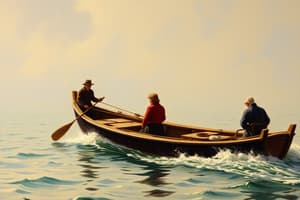Podcast
Questions and Answers
What factors does boat capacity depend on?
What factors does boat capacity depend on?
Hull volume, dimension, and engine weight and mounting.
The number of seats in a boat is NOT an indication of the number of people it can safely carry.
The number of seats in a boat is NOT an indication of the number of people it can safely carry.
True (A)
Boats less than 20 feet powered with an inboard, outboard, or stern drive engine manufactured after November 1, 1972 can be determined by certain safety standards.
Boats less than 20 feet powered with an inboard, outboard, or stern drive engine manufactured after November 1, 1972 can be determined by certain safety standards.
True (A)
According to U.S. Coast Guard statistics, capsizing is NOT a leading cause of fatal accidents.
According to U.S. Coast Guard statistics, capsizing is NOT a leading cause of fatal accidents.
What is the maximum capacity of boats powered by outboards?
What is the maximum capacity of boats powered by outboards?
What is the capacity consideration for boats powered by inboards and stern drives?
What is the capacity consideration for boats powered by inboards and stern drives?
What should the maximum capacity of manually propelled boats include?
What should the maximum capacity of manually propelled boats include?
For boats under 20 feet, or boats without a capacity plate, a way to determine how many people you may safely carry is to use the formula: Boat Length (in feet) X Beam (in feet) / ___
For boats under 20 feet, or boats without a capacity plate, a way to determine how many people you may safely carry is to use the formula: Boat Length (in feet) X Beam (in feet) / ___
What characterizes planing hulls?
What characterizes planing hulls?
What shape do displacement hulls typically have?
What shape do displacement hulls typically have?
What is a characteristic of flat bottom boats?
What is a characteristic of flat bottom boats?
What is a feature of round bottom boats?
What is a feature of round bottom boats?
What is the benefit of cathedral hulls?
What is the benefit of cathedral hulls?
What do deep-V hulls aim to achieve?
What do deep-V hulls aim to achieve?
What does a tunnel hull consist of?
What does a tunnel hull consist of?
Where must boat numbers be affixed?
Where must boat numbers be affixed?
Flashcards are hidden until you start studying
Study Notes
Boat Capacity
- Boat capacity is based on hull volume, dimensions, engine weight, and mounting.
- The number of seats does not indicate the safe carrying capacity of a boat.
Regulations for Boats
- Boats under 20 feet with specific engine types manufactured after November 1, 1972, have particular regulations.
- Capsizing is a leading cause of fatal boating accidents, contrary to some beliefs.
Capacity Standards for Different Boat Types
- Boats powered by outboards have distinct maximum capacities for persons and gear, alongside horsepower limits.
- Inboard and stern drive powered boats have different calculations for maximum person capacity and weight, not adhering to the Coast Guard Safe Powering Standard.
- Manually propelled boats have specified maximum capacities similar to powered boats.
Estimating Safe Capacity
- For boats under 20 feet or without capacity plates, use the formula: Boat Length (in feet) X Beam (in feet) / 15 to estimate safe carrying capacity.
Hull Types
- Planing Hulls: Designed to ride on top of the water; have flatter bottoms that allow for easier planning and higher speeds but poor handling in rough waters.
- Displacement Hulls: Rounded bottoms that efficiently displace water equal to their weight; limited speed based on waterline length (max speed is top-end = √(Waterline length) x 1.34).
- Flat Bottom: Common in small open boats, stable in calm waters but not in rough water; caution needed with stability.
- Round Bottom: Moves efficiently through water but tends to roll with waves, can cause seasickness.
- Cathedral Hull: Two or more hulls giving greater stability and potential for lift due to air pockets between them.
- Deep-V Hull: Designed for high speeds and rough water, offering smoother rides than flat or round hulls but requiring more power.
- Tunnel Hull: Associated with catamarans, combines deep-V hulls for stability and speed, effective in various seas.
Boat Identification
- Boat numbers must be displayed on the forward part of both port and starboard sides for identification purposes.
Studying That Suits You
Use AI to generate personalized quizzes and flashcards to suit your learning preferences.




